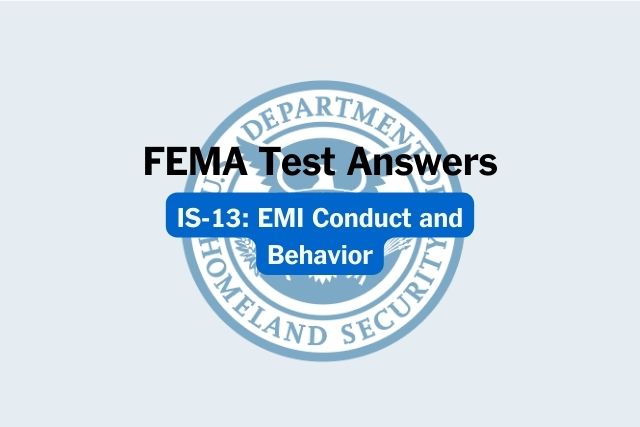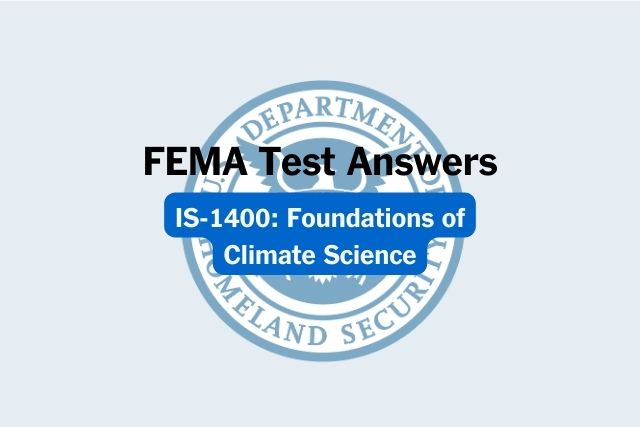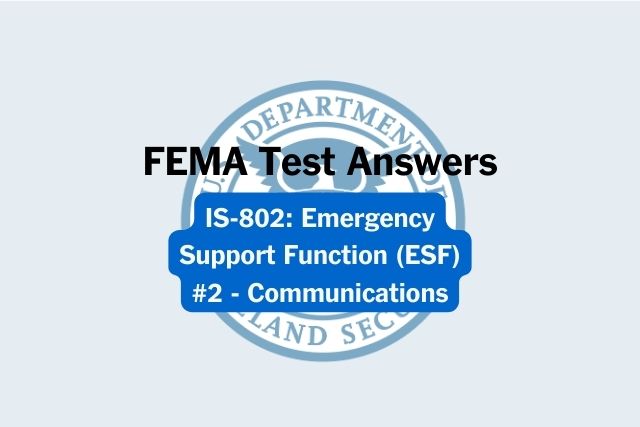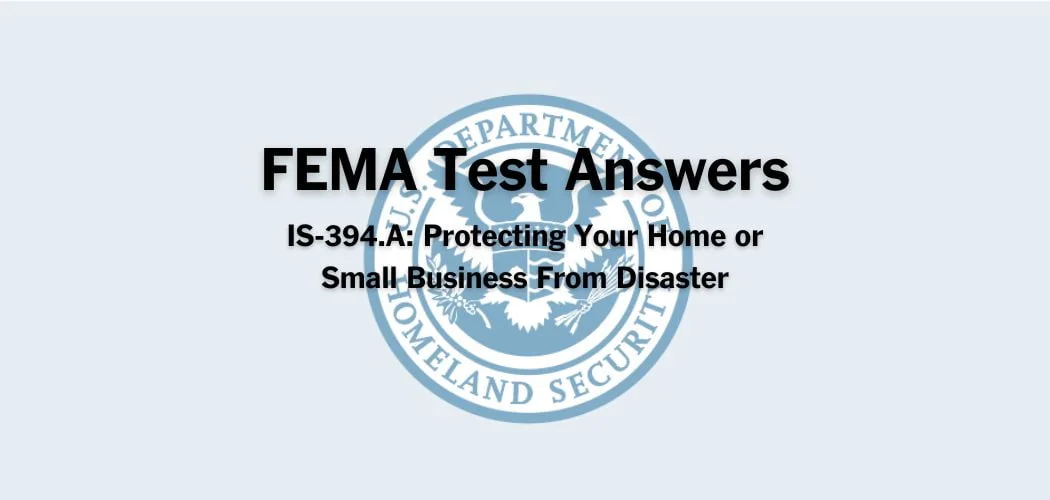Overview: FEMA IS-235.C course was published on 12/15/2015 and is designed for emergency management personnel who are involved in developing an effective emergency planning system.
Primary audience: All individuals involved in crisis and emergency management decision-making. FEMA IS-235.C offers training in the fundamentals of the emergency planning process, including the rationale behind planning. It will develop your capability for effective participation in the all-hazard emergency operations planning process to save lives and protect property threatened by disaster.
FEMA IS-235.C test answers
Each time this test is loaded, you will receive a unique set of questions and answers. The test questions are scrambled to protect the integrity of the exam.
Question 1. The planning team should represent the many facets of the community, including governmental and nongovernmental entities, the private sector, infrastructure owners and operators, and civic leaders.
A. TRUE✅
B. FALSE
Question 2. In the emergency planning process outlined in CPG 101, generating, comparing, and selecting possible courses of action to achieve desired outcomes is part of:
A. Step 2, Understand the situation
B. Step 6, Plan implementation and maintenance
C. Step 3, Determine goals and objectives
D. Step 4, Develop the Plan✅
Question 3. All of the following statements about plan approval and dissemination are true EXCEPT FOR:
A. “Sunshine” laws may require that a copy of the plan be placed in a location accessible to the public.
B. Each plan must be presented to the Department of Homeland Security for final approval.✅
C. Official promulgation is vital to gaining the widest acceptance possible for the plan.
D. It is important to make the plan available in alternate formats to ensure access by the whole community
Question 4. When completing a threat/hazard analysis, you should do all of the following actions, EXCEPT FOR:
A. Use existing THIRAs, hazard analyses, threat assessments, and homeland security strategies to identify initial threats and hazards.
B. Avoid recent history or official records since they may not always be the best indicator of the presence or severity of a threat or hazard.
C. Use online data sources and local subject-matter experts to understand potential threats and hazards.
D. Ask community organizations, critical infrastructure owners and operators, and other nontraditional partners to assist with the process.✅
Question 5. When an emergency operations plan has been developed and approved, what step remains to be done?
A. Determine goals and objectives.
B. No steps remain; the process is complete.
C. Implement and maintain the plan.✅
D. Inform the response community that a plan has been developed.
Question 6. Each of the following should trigger a review of the emergency plan, EXCEPT FOR:
A. Plan activation during an incident or exercise.
B. Hiring of new emergency management agency support staff.✅
C. Changes in operational resources or jurisdiction demographics.
D. Changes in laws, ordinances, or elected or appointed officials.
Question 7. Which of the following statements is FALSE?
A. Emergency plans communicate what should happen, why it is done, and what to expect from it.
B. Emergency plans clarify how functions and activities are to be coordinated and how they complement one another.
C. Emergency plans ensure that all resources can be obtained through internal sources within the jurisdiction.✅
D. Emergency plans delineate roles and responsibilities.
Question 8. One purpose of providing training on the emergency plan is to ensure that stakeholders are prepared to communicate and coordinate with others involved in implementing the plan.
A. TRUE✅
B. FALSE
Question 9. Select the TRUE statement:
A. An emergency plan is considered up-to-date if it has been reviewed at least once in the last decade.
B. An emergency plan only needs to be updated when there is a revision in the laws, codes, or ordinances that govern emergency planning.
C. An emergency plan should be reviewed and updated at least every 1 or 2 years and after key events, including plan activation.✅
D. The best time to review and update an emergency plan is during a major activation of the plan, while personnel are focused on the policies and procedures.
Question 10. Which of the following is a TRUE statement about Threat and Hazard Identification and Risk Assessment (THIRA)?
A. THIRA is a comprehensive process for identifying threats and hazards along with their associated capabilities.✅
B. If a jurisdiction has an emergency operations plan, there is no reason to do a THIRA.
C. National capability targets to be implemented by jurisdictions are pre-established in THIRA.
D. THIRA replaces the need for strategic and operational planning within each of the mission areas.
Question 11. All of the following are true of emergency planning EXCEPT FOR:
A. It identifies tasks, allocates resources, and establishes accountability.
B. It is most effective when it focuses on a single threat/hazard at a time.✅
C. It should involve all stakeholders in the community.
D. It uses a logical, analytical problem-solving process.
Question 12. The goal of preparedness is a secure and resilient Nation with the capabilities required across the whole community to prevent, protect against, mitigate, respond to, and recover from the threats and hazards that pose the greatest risk.
A. TRUE✅
B. FALSE
Question 13. What are core capabilities?
A. Individual competencies that each emergency management professional should possess in order to receive credentials.
B. Distinct elements that are essential for the execution of each mission area.✅
C. Skills, knowledge, and aptitudes that jurisdictions must develop before they can begin the planning process.
D. Standards that jurisdictions must meet in order to receive grant funding.
Question 14. Planning teams are most effective when:
A. Membership is confined to people in the same agency or organization.
B. Community groups with competing views are excluded from the team.
C. The group finds common ground on which to build consensus for action.✅
D. The group leader takes primary responsibility for decision-making.
Question 15. An emergency plan element that focuses on special planning needs generated by a bioterrorism attack is an example of a/an:
A. Basic plan.
B. Supporting annex.
C. Threat/hazard/incident-specific annex.✅
D. Implementing instruction.
Question 16. Forming a planning team removes individual accountability if problems arise during incident response.
A. TRUE
B. FALSE✅
Question 17. The planning process set out in CPG 101:
A. Is suitable for planning by all levels of government.✅
B. Is best suited for strategic planning rather than operational planning.
C. Is not appropriate for use by private entities.
D. Applies only to the development of new plans, not plan updates.
Question 18. A key planning principle is that plans are most coherent when developed by a single emergency management professional and then presented to the response community for approval.
A. TRUE
B. FALSE✅
Question 19. The emergency planning process includes the following steps: (1) Form a collaborative planning team; (2) Understand the situation; (3) ________; (4) Develop the plan; (5) Prepare, review, and get approval; and (6) Implement and maintain the plan. Select the missing Step 3 from below:
A. Step 3. Conduct a hazard analysis.
B. Step 3. Submit an outline for Federal approval.
C. Step 3. Assign responsibilities for mission assignments.
D. Step 3. Determine goals and objectives.✅
Question 20. An emergency operations plan delineates:
A. Agency coordination during long-term recovery efforts.
B. How people and property will be protected during an emergency.✅
C. How predisaster choices can manage or reduce long-term risk.
D. The importance of intelligence about imminent threats in thwarting terrorist attacks.
Question 21. As defined in CPG 101, the first step in the emergency planning process is to:
A. Conduct a threat/hazard analysis.
B. Conduct training and exercises to ensure that the correct goals and objectives have been identified.
C. Form a collaborative planning team.✅
D. Seek State and Federal approval for undertaking a planning effort.
Question 22. Detailed guidance for developing emergency plans can be found in:
A. Presidential Policy Directive (PPD) 8.
B. National Response Framework.
C. Comprehensive Preparedness Guide (CPG) 101.✅
D. National Preparedness Goal.
Question 23. What role do nongovernmental organizations (NGOs) play in emergency planning?
A. NGOs have no appropriate role in the planning process.
B. NGOs best role is to provide their constituencies’ perspectives during the final review of the plan.
C. NGOs only role is to provide volunteers during an emergency.✅
D. NGOs should be involved as a stakeholder in the planning process.
Question 24. Which of the following is a FALSE statement?
A. Preparedness activities take place before, during, and after an incident.
B. Preparedness derives from building and sustaining the capabilities that are necessary to deal with great risks.
C. Preparedness results from building and sustaining core capabilities in each of the five mission areas.
D. Preparedness requires the development of a separate emergency plan for each identified threat and hazard.✅
Question 25. What role does the private sector play in emergency planning?
A. The private sector’s only emergency management role is the provision of resources during an emergency.
B. The private sector has no appropriate role in the planning process.
C. The private sector should be involved as a stakeholder in the planning process.✅
D. The private sector’s best role is to provide the business perspective during the final review of the plan.
Question 26. Concept of Operations is a standard element of a basic plan.
A. TRUE✅
B. FALSE
Question 27. An effective way to test and evaluate plans, policies, procedures, and coordination of decision-making is by:
A. Presenting seminars and briefings.
B. Providing job aids.
C. Organizing on-the-job training.
D. Conducting exercises.✅
Question 28. Step 4 of the planning process is plan development. This step involves generating courses of action, identifying required resources, and:
A. Estimating capabilities and shortfalls.✅
B. Obtaining approval from Federal authorities.
C. Determining what threats and hazards the jurisdiction faces.
D. Eliminating courses of action that would require outside resources.
Question 29. The process for developing emergency operations plans is outlined in the Comprehensive Preparedness Guide (CPG) 101.
A. TRUE✅
B. FALSE
Question 30. When possible, the planning team should build on existing assessments such as Hazard Identification and Risk Assessments prepared by the States, major urban areas, and other government entities.
A. TRUE✅
B. FALSE
Popular FEMA test answers
- IS-005: An Introduction to Hazardous Materials
- IS-010: Animals in Disasters: Awareness and Preparedness
- IS-100: An Introduction to the Incident Command System (ICS)
- IS-120: An Introduction to Exercises
- IS-230: Fundamentals of Emergency Management
- IS-244: Developing and Managing Volunteers
- IS-363: Introduction to Emergency Management for Higher Education
- IS-700: An Introduction to the National Incident Management System
- IS-906: Workplace Security Awareness
- IS-907: Active Shooter: What You Can Do
- IS-909: Community Preparedness: Implementing Simple Activities for Everyone



